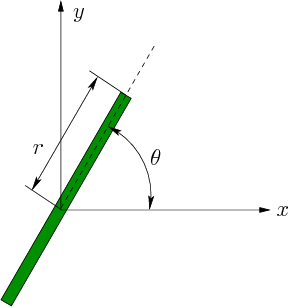
Next: 13.1.2.4 A car pulling Up: 13.1.2 Kinematics for Wheeled Previous: 13.1.2.2 A differential drive
 |
Consider the simple model of a unicycle, which is shown in Figure
13.5. Ignoring balancing concerns, there are two action
variables. The rider of the unicycle can set the pedaling speed and
the orientation of the wheel with respect to the ![]() -axis. Let
-axis. Let
![]() denote the pedaling angular velocity, and let
denote the pedaling angular velocity, and let ![]() be
the wheel radius. The speed of the unicycle is
be
the wheel radius. The speed of the unicycle is
![]() . In
this model, the speed is set directly by an action variable
. In
this model, the speed is set directly by an action variable ![]() (alternatively, the pedaling rate could be an action variable
(alternatively, the pedaling rate could be an action variable
![]() , and the speed is derived as
, and the speed is derived as
![]() ). Let
). Let
![]() be the angular velocity of the unicycle orientation in the
be the angular velocity of the unicycle orientation in the
![]() plane (hence,
plane (hence,
![]() ). Let
). Let ![]() be directly
set by an action variable
be directly
set by an action variable ![]() . The configuration transition
equation is
. The configuration transition
equation is
Steven M LaValle 2012-04-20